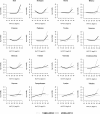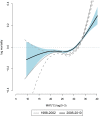Changes in the effects of heat on mortality among the elderly from 1998-2010: results from a multicenter time series study in Italy
- PMID: 22943217
- PMCID: PMC3506566
- DOI: 10.1186/1476-069X-11-58
Changes in the effects of heat on mortality among the elderly from 1998-2010: results from a multicenter time series study in Italy
Abstract
Background: This multicenter study is aimed at estimating changes in the effect of high temperatures on elderly mortality before and after the 2003 heat waves and following the introduction of heat prevention activities.
Methods: A total of sixteen cities were included in the study. City-specific relationships between maximum apparent temperature (MAT) and elderly daily mortality before (1998-2002) and after (2006-2010) intervention were modelled through non-linear distributed lag models and estimates were combined using a random effect meta-analysis. We estimated the percentage change in daily mortality for 3°C variations in MAT above the 25th percentile of the June city-specific 1998-2002 distribution. A time-varying analysis was carried out to describe intra-seasonal variations in the two periods.
Results: We observed a reduction in high temperatures' effect post intervention; the greatest reduction was for increases in temperature from 9°C to 12°C above the 25th percentile, with a decrease from +36.7% to +13.3%. A weak effect was observed for temperatures up to 3°C above the 25th percentile only after. Changes were month-specific with a reduction in August and an increase in May, June and September in 2006-2010.
Conclusions: A change in the temperature-mortality relationship was observed, attributable to variations in temperature distributions during summer and to the introduction of adaptation measures. The reduction in the effect of high temperature suggests that prevention programs can mitigate the impact. An effect of lower temperature remains, indicating a relevant impact of temperature at the beginning of summer when the population has not yet adapted and intervention activities are not fully operational.
Figures




Similar articles
-
Temporal variation in the effect of heat and the role of the Italian heat prevention plan.Public Health. 2018 Aug;161:154-162. doi: 10.1016/j.puhe.2018.03.030. Epub 2018 May 8. Public Health. 2018. PMID: 29751981
-
Airport and city-centre temperatures in the evaluation of the association between heat and mortality.Int J Biometeorol. 2008 Mar;52(4):301-10. doi: 10.1007/s00484-007-0124-5. Epub 2007 Nov 21. Int J Biometeorol. 2008. PMID: 18030502
-
Heat effects on mortality in 15 European cities.Epidemiology. 2008 Sep;19(5):711-9. doi: 10.1097/EDE.0b013e318176bfcd. Epidemiology. 2008. PMID: 18520615
-
Air temperature-related human health outcomes: current impact and estimations of future risks in Central Italy.Sci Total Environ. 2012 Dec 15;441:28-40. doi: 10.1016/j.scitotenv.2012.09.056. Epub 2012 Nov 4. Sci Total Environ. 2012. PMID: 23134767
-
Exploring the association between heat and mortality in Switzerland between 1995 and 2013.Environ Res. 2017 Oct;158:703-709. doi: 10.1016/j.envres.2017.07.021. Epub 2017 Jul 20. Environ Res. 2017. PMID: 28735231
Cited by
-
Long-term changes in the heat-mortality relationship according to heterogeneous regional climate: a time-series study in South Korea.BMJ Open. 2016 Aug 3;6(8):e011786. doi: 10.1136/bmjopen-2016-011786. BMJ Open. 2016. PMID: 27489155 Free PMC article.
-
Ambient extreme heat exposure in summer and transitional months and emergency department visits and hospital admissions due to pregnancy complications.Sci Total Environ. 2021 Jul 10;777:146134. doi: 10.1016/j.scitotenv.2021.146134. Epub 2021 Mar 1. Sci Total Environ. 2021. PMID: 33689898 Free PMC article.
-
Heat-related respiratory hospital admissions in Europe in a changing climate: a health impact assessment.BMJ Open. 2013 Jan 24;3(1):e001842. doi: 10.1136/bmjopen-2012-001842. BMJ Open. 2013. PMID: 23355662 Free PMC article.
-
Temperature-mortality relationship in North Carolina, USA: Regional and urban-rural differences.Sci Total Environ. 2021 Sep 15;787:147672. doi: 10.1016/j.scitotenv.2021.147672. Epub 2021 May 11. Sci Total Environ. 2021. PMID: 34000533 Free PMC article.
-
Temporal Variation in Heat-Mortality Associations: A Multicountry Study.Environ Health Perspect. 2015 Nov;123(11):1200-7. doi: 10.1289/ehp.1409070. Epub 2015 May 1. Environ Health Perspect. 2015. PMID: 25933359 Free PMC article.
References
-
- WHO Regional Office for Europe. Fifth Ministerial Conference on Environment and Health. Parma, Italy; 2010. pp. 10–12. www.euro.who.int/en/who-we-are/policy-documents/parma-declaration-on-env...(accessed March 23, 2012)
-
- IPCC, 2007. Summary for Policymakers. In: Parry ML, Canziani OF, Palutikof JP, van der Linden PJ, Hanson CE, editor. Climate Change 2007: Impacts, Adaptation and Vulnerability. Contribution of Working Group II to the Fourth Assessment Report of the Intergovernmental Panel on Climate Change. Cambridge University Press, Cambridge, UK; 2007. pp. 7–22.
-
- Davis RE, Knappenberger PC, Novicoff WM, Michaels PJ. Decadal changes in summer mortality in U.S. cities. Int J Biometeorol. 2003;47:166–175. - PubMed
Publication types
MeSH terms
LinkOut - more resources
Full Text Sources
Molecular Biology Databases

